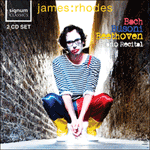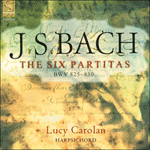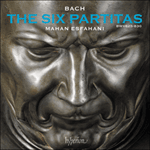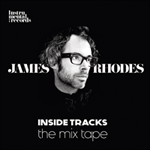With the Partita No 6 in E minor Bach gives us one of his greatest masterpieces. It is a stupendous work on the grandest scale—one in which we feel his incredible strength of character, security, warmth of heart and deep faith. Here he is no longer writing for popular appeal but on the highest intellectual and emotional plane. The work opens with a Toccata where similar outer sections frame an extended fugue. Both the opening measure and the subject of the fugue make use of the ‘sigh’ motif (a descending appoggiatura) to add extra expressivity. By keeping the same basic tempo throughout the Toccata, unity is achieved (this seems to be called for by Bach as material from the first page later appears in the last episode of the fugue). The Allemande, with its poignant chromaticisms, is followed by a remarkable Corrente. One’s fingers can take an almost physical pleasure in executing its mischievous syncopations with delicacy, rapidity and brilliance. A brief Air, with a surprising second ending, precedes the Sarabande—surely one of Bach’s greatest creations. At first sight (or upon first hearing) this movement can seem baffling. It takes time to discover the framework beneath the profusion of notes, and to realize its emotional power. For me Bach is alone in this Sarabande—alone in communion with his maker in a dialogue that is at once sorrowful, hopeful, passionate, and at times exalted (the marvellous, brief modulations into major keys in bars 7, 8 and 30 interrupt the darkness with flashes of light). To go from deep inside Bach’s inner world (and therefore our own) straight into the Tempo di Gavotta can come as a bit of a shock, but we can only marvel at how Bach immediately begins to dance—even in a minor key. This is not a true gavotte—it is much more like an Italian Giga in 12/8 time. In this, and in the concluding Gigue, the interpreter faces the problem of possible alteration of note values. Playing the semiquavers to coincide with the triplets gives the Tempo di Gavotta more bounce (as does the shortening of the first two notes in the right hand). There are two very different ways of playing the Gigue fugue. One is to play a version in triple metre, bringing it somewhat closer to a traditional jig; the other is to play it exactly as written, emphasizing its angularity. I opt for the latter both because I feel the fugue subject loses force if altered and also to provide greater contrast with the preceding gavotte. Bach really outdoes himself in this final Gigue, demanding the utmost in mental virtuosity from the player. At a lively tempo the severe counterpoint can still be made to dance. Even if, in the six Partitas, my greatest affection lies with the D major Allemande, for this final Partita I say to Bach, ‘Hats off!’
from notes by Angela Hewitt © 1997
Avec la Partita nº 6 en mi mineur, Bach nous offre l’un de ses plus grands chefs-d’œuvre—une pièce prodigieuse, à la plus grande échelle qui soit, dans laquelle il nous donne à sentir son incroyable puissance de caractère, son assurance, son cœur chaleureux, sa foi profonde. Là, Bach n’écrit plus pour plaire, mais compose au plus haut niveau intellectuel et émotionnel. L’œuvre s’ouvre sur une toccata, où des sections extrêmes identiques encadrent une fugue prolongée. La mesure d’ouverture et le sujet de la fugue utilisent le motif de «soupir» (une appogiature descendante) pour ajouter de l’expressivité. La conservation du même tempo de base tout au long de la toccata permet la réalisation de l’unité (ce qui semble être voulu par Bach, puisque le matériau de la première page apparaît ultérieurement dans le dernier épisode de la fugue). L’allemande, avec ses chromatismes poignants, est suivie d’une remarquable courante. Les doigts peuvent prendre un plaisir quasi physique à exécuter ses syncopes espiègles avec délicatesse, rapidité et brio. Un air bref, doté d’une seconde fin surprenante, précède la sarabande—sûrement l’une des plus grandes créations de Bach. À première vue (ou à première écoute), ce mouvement peut sembler déconcertant et il faut du temps pour découvrir la trame sous la profusion de notes, pour réaliser son pouvoir émotionnel. À mes yeux, Bach est seul dans cette sarabande—seul, en communion avec son créateur, dans un dialogue à la fois triste, plein d’espoir, passionné et, parfois, exalté (les brèves et merveilleuses modulations en tonalités majeures dans les mesures 7, 8 et 30 rompent l’obscurité par des éclairs de lumière). Passer directement du tréfonds de l’univers intérieur de Bach (et donc du nôtre) au tempo di gavotta peut être subi comme un choc, et nous ne pouvons que nous émerveiller de la manière dont Bach commence immédiatement à danser—même dans une tonalité mineure. Il ne s’agit pas là d’une véritable gavotte, mais plutôt d’une sorte de giga italienne, à 12/8. Ici, et dans la gigue conclusive, l’interprète est confronté au problème de l’altération possible des valeurs des notes. Jouer les doubles croches pour coïncider avec les triolets donne plus de volume au tempo di gavotta (à l’instar du raccourcissement des deux premières notes dans la main droite). Il existe deux façons très différentes de jouer la fugue de la gigue. L’une consiste à exécuter une version en mesure ternaire, et donc à aboutir à quelque chose de plus proche d’une gigue traditionnelle; l’autre consiste à s’en tenir strictement à ce qui fut écrit, et donc à souligner l’angularité du passage. J’opte pour cette seconde possibilité, convaincue que le sujet de la fugue perd en force s’il est altéré, mais aussi soucieuse de ménager un contraste plus grand avec la gavotte précédente. Bach se surpasse véritablement dans cette gigue finale, qui demande à l’interprète la plus extrême virtuosité mentale. Dans un tempo animé, l’austère contrepoint peut encore être fait pour danser. Même si, parmi les six Partitas, ma préférence va à l’allemande de celle en ré majeur, je ne puis que dire à propos de cette dernière partita, «Chapeau bas!»
extrait des notes rédigées par Angela Hewitt © 1997
Français: Hypérion
Mit der Partita Nr. 6 in e-Moll hat uns Bach ein großartiges Meisterwerk geschenkt. Es ist ein phantastisches Werk in allergrößtem Stil, ein Werk, das uns Bachs unglaubliche Charakterstärke, Sicherheit, menschliche Wärme und seinen unerschütterlichen Glauben spüren läßt. Er komponiert hier nicht mehr zum allgemeinen Vergnügen, sondern auf höchster intellektueller und emotionaler Ebene. Das Werk beginnt mit einer Toccata, wobei eine erweiterte Fuge von ähnlichen Eckpassagen eingefaßt wird. Sowohl das anfängliche Zeitmaß als auch das Fugenthema machen von dem „Seufzer“-Motiv (einem absteigendem Vorschlag) Gebrauch, um dem Stück noch mehr Ausdruck zu verleihen. Durch das Beibehalten des Originaltempos während der gesamten Toccata wird ein Gefühl von Geschlossenheit erreicht (dies schien Bachs Absicht, da Material der ersten Seite später, in der letzten Fugenepisode, erneut auftaucht). Der Allemande mit ihrer wehmütigen Chromatik schließt sich eine außergewöhnliche Courante an: Das Spiel der kniffligen Synkopen mit entsprechendem Feingefühl sowie Behendigkeit und Brillanz kann den Fingern einen fast sinnlichen Genuß bereiten. Ein kurzes Air mit einem überraschenden zweiten Ende geht einer Sarabande voraus—sicher eine von Bachs hervorragendsten Kompositionen. Auf den ersten Blick (oder beim ersten Anhören) mag dieser Satz verblüffen. Es bedarf einiger Zeit, um das der Notenfülle zugrundeliegende Gerüst zu erkennen und sich dessen starker emotionaler Wirkung bewußt zu werden. Für mich ist Bach in dieser Sarabande allein—allein mit seinem Schöpfer in einem Zwiegespräch, in welchem Trauer, Hoffnung, Leidenschaft und manchmal Überschwang zugleich zum Ausdruck kommen (die herrlichen, kurzen Modulationen nach Dur in den Takten 7, 8 und 30 erhellen das Dunkel wie gleißende Blitze). Der direkte Schritt von Bachs tiefstem Innern (und folglich auch unserem eigenen) in das Tempo di Gavotta wirkt wie ein Kreislaufschock, doch Bachs unverzügliches Betreten der Tanzfläche—selbst in einer Molltonart—ist schlichtweg bewundernswert. Wir haben es hier jedoch nicht mit einer richtigen Gavotte zu tun, vielmehr mit einer italienischen Giga im 12/8-Takt. In diesem Stück, sowie in der abschließenden Gigue, wird der Interpret mit dem Problem möglicher Veränderungen der Notenwerte konfrontiert. Das zeitliche Zusammenspiel der Sechzehntelnoten und Triolen verleiht dem Tempo di Gavotta mehr Schwung (ebenso wie die Verkürzung der ersten zwei Noten der rechten Hand). Diese Gigue-Fuge läßt sich grundsätzlich auf zwei verschiedene Weisen spielen: erstens als eine Dreiertakt-Version, die der traditionellen Gigue näherkommt, und zweitens genau nach Vorgabe, mit der Betonung auf der fugalen Kantigkeit. Ich persönlich bevorzuge letztere Spielweise, da das Fugenthema meiner Meinung nach durch Veränderungen an Ausdrucksstärke einbüßt, und weil somit ein stärkerer Kontrast zur vorhergehenden Gavotte hergestellt wird. In dieser abschließenden Gigue, die dem Spieler allerhöchste geistige Virtuosität abverlangt, übertrifft sich Bach wahrlich selbst. Selbst der strenge Kontrapunkt kann bei einem lebhaften Tempo immer noch tanzbar sein. Zwar gilt von allen Stücken dieser sechs Partiten meine ganze Liebe der D-Dur-Allemande, doch zu dieser letzten Partita kann ich nur sagen: „Hut ab, Herr Bach!“
aus dem Begleittext von Angela Hewitt © 1997
Deutsch: Manuela Hübner


 Bach: Angela Hewitt – The Bach Recordings
Bach: Angela Hewitt – The Bach Recordings Bach, Busoni & Beethoven: Piano Recital
Bach, Busoni & Beethoven: Piano Recital Bach: Angela Hewitt plays Bach
Bach: Angela Hewitt plays Bach Bach: The Six Partitas
Bach: The Six Partitas Bach: The Six Partitas
Bach: The Six Partitas Bach: The Six Partitas
Bach: The Six Partitas Inside tracks - the James Rhodes mix tape
Inside tracks - the James Rhodes mix tape
